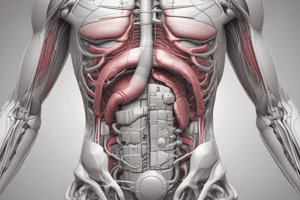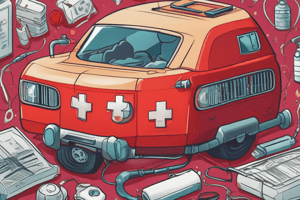Podcast
Questions and Answers
The __________ lies in the retroperitoneal space.
The __________ lies in the retroperitoneal space.
- Pancreas (correct)
- Small intestine
- Liver
- Stomach
Which of the following is NOT a solid organ?
Which of the following is NOT a solid organ?
- Gallbladder (correct)
- Kidney
- Spleen
- Liver
Based on your findings, you should suspect:
Based on your findings, you should suspect:
- Appendicitis
- Cholecystitis
- Pancreatitis
- Peritonitis (correct)
Most patients with an acute abdomen present with:
Most patients with an acute abdomen present with:
Which of the following signs or symptoms would you be LEAST likely to find in a patient with an acute abdomen?
Which of the following signs or symptoms would you be LEAST likely to find in a patient with an acute abdomen?
A condition in which a person experiences a loss of appetite is called:
A condition in which a person experiences a loss of appetite is called:
The medical term for inflammation of the urinary bladder is:
The medical term for inflammation of the urinary bladder is:
If a hernia is incarcerated and the contents are so greatly compressed that circulation is compromised, the hernia is said to be:
If a hernia is incarcerated and the contents are so greatly compressed that circulation is compromised, the hernia is said to be:
Treatment for a patient with severe, tearing abdominal pain that radiates to the back should include:
Treatment for a patient with severe, tearing abdominal pain that radiates to the back should include:
In which position do most patients with acute abdominal pain prefer to be transported?
In which position do most patients with acute abdominal pain prefer to be transported?
Flashcards are hidden until you start studying
Study Notes
Retroperitoneal Space
- The pancreas lies in the retroperitoneal space, behind the peritoneum.
- Other organs in this space include the kidneys and ovaries.
- Acute abdominal pain may arise from conditions affecting retroperitoneal organs.
Solid vs. Hollow Organs
- The gallbladder is a hollow organ responsible for storing and concentrating bile.
- In contrast, the liver, kidney, and spleen are classified as solid organs.
- Understanding organ classification is essential for assessing abdominal conditions.
Peritonitis
- Peritonitis is the inflammation of the membrane lining the abdominal cavity, causing diffuse abdominal pain.
- Common causes include infections and abdominal trauma.
- This condition differs from appendicitis, pancreatitis, and cholecystitis, which typically present with localized pain.
Acute Abdomen Presentation
- Tachycardia is a common symptom among patients presenting with an acute abdomen.
- Distress signals include rapid heart rate in response to pain or shock.
Signs and Symptoms of Acute Abdomen
- A soft, nondistended abdomen is least likely to be found in acute abdomen cases, often indicating non-serious conditions.
- Other common symptoms include tachycardia, rapid shallow breathing, and restlessness.
Loss of Appetite
- Anorexia is the medical term for a loss of appetite, impacting patients with various conditions.
Urinary Bladder Inflammation
- Cystitis refers to the inflammation of the urinary bladder, while nephritis pertains to kidney inflammation.
Hernia Complications
- An incarcerated hernia with compromised circulation is termed strangulated.
- Prompt medical intervention is necessary to prevent further complications.
Suspected Abdominal Aortic Aneurysm (AAA)
- Severe, tearing abdominal pain radiating to the back is characteristic of AAA, particularly in older patients with a history of hypertension.
- Immediate treatment includes rapid transport to medical facilities and administration of high-flow oxygen.
- Avoid firm abdominal palpation to prevent risk of aneurysm rupture.
Position Preference for Acute Abdominal Pain
- Patients with acute abdominal pain often prefer to be transported on their side with knees flexed to alleviate discomfort.
Studying That Suits You
Use AI to generate personalized quizzes and flashcards to suit your learning preferences.




